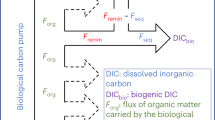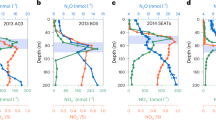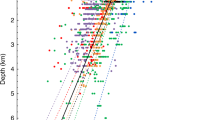Abstract
The flux of biologically produced organic carbon from the euphotic zone of the ocean to the deep waters below—the ‘biological organic carbon pump’—is one of the main controls on the carbon dioxide partial pressure in the atmosphere1. Accurate determination of this flux is therefore critically important for understanding the global carbon cycle and its response to climate change. Our goal is to assess how accurately the biological organic carbon pump can be determined at a single location and to constrain estimates of the global value. As there are no standards against which such environmental fluxes can be measured, we assess accuracy by comparing results from three independent experimental approaches for measuring the net annual export of organic carbon from the euphotic zone in the subtropical North Pacific Ocean near Hawaii. Mass balances of dissolved oxygen, inorganic carbon and organic carbon yield estimates of the organic carbon export flux of 2.7 ± 1.7, 1.6 ± 0.9 and 2.0 ± 0.9 mol C m−2 yr−1, respectively. These three estimates are not significantly different, and establish the present analytically attainable accuracy at this location to be about ±50%. If 2.0 mol C m−2 yr−1 is typical of the organic carbon export flux in the subtropical ocean, then this vast region, often considered to be a biological desert, may be responsible for up to half of the global-ocean biological organic carbon pump.
This is a preview of subscription content, access via your institution
Access options
Subscribe to this journal
Receive 51 print issues and online access
$199.00 per year
only $3.90 per issue
Buy this article
- Purchase on Springer Link
- Instant access to full article PDF
Prices may be subject to local taxes which are calculated during checkout



Similar content being viewed by others
References
Sarmiento, J. L. & Siegenthalerr, U. in Primary Productivity and Biogeochemical Cycles in the Sea (eds Falkowski, P. G. & Woodhead, A. D.) 317–332 (Plenum, New York, (1992)).
Karl, D. M. & Lukas, R. The Hawaii Ocean Time-series (HOT) program: Background, rationale and field implementation. Deep-Sea Res. II 43, 129–147 (1996).
Karl, D. M. et al. Seasonal and interannual variability in primary production and particle flux at Station ALOHA. Deep-Sea Res. II 43, 539–569 (1996).
Winn, C. D., Mackenzie, F. T., Carrillo, C. J., Sabine, C. L. & Karl, D. M. Air–sea carbon dioxide exchange in the North Pacific subtropical gyre: Implications for the global carbon budget. Glob. Biogoechem. Cycles 8, 157–163 (1994).
Quay, P. D. & Andersen, H. Organic carbon export rates in the Subtropical N. Pacific. Eos 76, OS85 (1996).
Emerson, S., Quay, P. D., Stump, C., Wilber, D. & Schudlich, R. Chemical tracers of productivity and respiration in the subtropical Pacific Ocean. J. Geophys. Res. 100, 15873–15887 (1995).
Sabine, C. L., Mackenzie, F. T., Winn, C. & Karl, D. M. The influence of air–sea exchange on the isotopic composition of oceanic carbon: Observations and modelling. Glob. Biogeochem. Cycles 9, 637–652 (1995).
Laws, E. A. Photosynthetic quotients, new production and net community production in the open ocean. Deep-Sea Res. 38, 143–167 (1991).
Keeling, R. On the role of large bubbles in air–sea exchange and supersaturation in the ocean. J. Mar. Res. 51, 237–271 (1993).
Woolf, D. Bubbles and air–sea transfer velocity of gases. Atmos. Ocean 31, 517–540 (1993).
Schudlich, R. & Emerson, S. Gas saturation in the surface ocean: The roles of heat flux, gas exchange and bubbles. Deep-Sea Res. II 43, 569–591 (1996).
Liss, P. S. & Merlivat, L. in The Role of Air–Sea Exchange in Geochemical Cycling (ed. Buat-Ménard, P.) 112–127 (Reidel, Norwell, MA, (1986)).
Wanninkhof, R. Relationship between wind speed and gas exchange over the ocean. J. Geophys. Res. 97, 7373–7382 (1992).
Roden, G. I. On the subtropical frontal zone north of Hawaii in winter. J. Phys. Oceanogr. 10, 342–362 (1980).
Jenkins, W. Using anthropogenic tritium and 3He to study subtropical gyre ventilation and circulation. Phil. Trans. R. Soc. Lond. A 325 43–61 (1988).
Zhang, J. & Quay, P. D. The total organic carbon export rate based on 13C and 12C of DIC budgets in the Equatorial Pacific region. Deep-Sea Res. II(in the press).
Broecker, W. S. & Peng, T. H. Gas exchange rates between air and sea. Tellus XXVI, 21–35 (1974).
Longhurst, A. R. & Harrison, W. G. The biological pump: profiles of plankton and consumption in the upper ocean. Prog. Oceanogr. 22, 46–123 (1989).
Ikeda, T. Metabolic rates of epipelagic marine zooplankton as a function of body mass and temperature. Mar. Biol. 85, 1–11 (1985).
Carlson, C. A., Ducklow, H. W. & Michaels, A. F. Annual flux of dissolved organic carbon from the euphotic zone of the northwest Sargasso Sea. Nature 371, 405–408 (1994).
Tupas, L. M., Popp, B. N. & Karl, D. Dissolved organic carbon in oligotrophic waters: Experiments on sample preservation, storage and analysis. Mar. Chem. 41, 207–216 (1993).
Eppley, R. W. & Peterson, B. J. Particulate organic flux and planktonic new production in the deep ocean. Nature 282, 677–680 (1979).
Martin, J. H., Knauer, G. A., Karl, D. M. & Broenkow, B. B. VERTEX: Carbon cycling in the northeast Pacific. Deep-Sea Res. 34, 267–285 (1987).
Six, K. D. & Maier-Reimerr, E. Effect of plankton dynamics on the seasonal carbon fluxes in a ocean general circulation model. Glob. Biogeochem. Cycles 10, 559–583 (1996).
Karl, D. M. et al. The role of dinitrogen fixation in the nitrogen budget of the subtropical North Pacific Ocean. Nature 388, 533–538 (1997).
Quay, P. D., Emerson, S., Wilber, D. O. & Stump, C. The δ18O of dissolved O2in the surface waters of the subarctic Pacific: a tracer of biological productivity. J. Geophys. Res. 98, 8447–8458 (1993).
Goericke, R. & Fry, B. variations of marine plankton δ13C with latitude, temperature and dissolved CO2in the world ocean. Glob. Biogeochem. Cycles 8, 85–90 (1994).
Emerson, S., Quay, P. D., Stump, C., Wilber, D. & Knox, M. O2, Ar, N2and 222Rn in surface waters of the subarctic Pacific Ocean. Glob. Biogeochem. Cycles 5, 49–69 (1991).
Acknowledgements
We thank C. Stump, D. Wilber and D. Hebel for technical work which helped make this study possible. This work was supported by the NSF.
Author information
Authors and Affiliations
Corresponding author
Rights and permissions
About this article
Cite this article
Emerson, S., Quay, P., Karl, D. et al. Experimental determination of the organic carbon flux from open-ocean surface waters. Nature 389, 951–954 (1997). https://doi.org/10.1038/40111
Received:
Accepted:
Issue Date:
DOI: https://doi.org/10.1038/40111
This article is cited by
-
The particle fluxes in sediment traps from Niulang Guyot area in the Northwest Pacific Ocean
Acta Oceanologica Sinica (2022)
-
Isolation of the South China Sea from the North Pacific Subtropical Gyre since the latest Miocene due to formation of the Luzon Strait
Scientific Reports (2021)
-
Nanomolar phosphate supply and its recycling drive net community production in the subtropical North Pacific
Nature Communications (2021)
-
Combined pigment and metatranscriptomic analysis reveals highly synchronized diel patterns of phenotypic light response across domains in the open oligotrophic ocean
The ISME Journal (2021)
-
Should we account for mesozooplankton reproduction and ontogenetic growth in biogeochemical modeling?
Theoretical Ecology (2021)
Comments
By submitting a comment you agree to abide by our Terms and Community Guidelines. If you find something abusive or that does not comply with our terms or guidelines please flag it as inappropriate.



